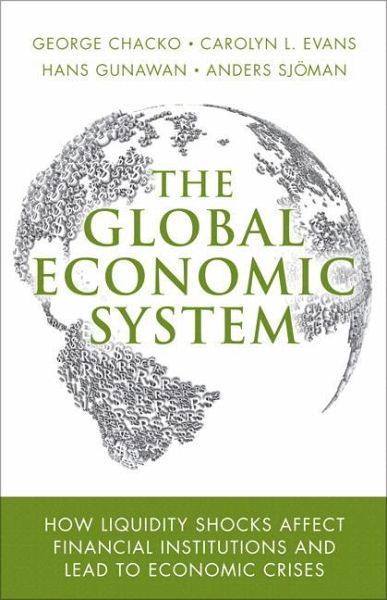
The Global Economic System
How Liquidity Shocks Affect Financial Institutions and Lead to Economic Crises
Versandkostenfrei!
Versandfertig in über 4 Wochen
25,99 €
inkl. MwSt.

PAYBACK Punkte
13 °P sammeln!
This is the first professional-level authoritative guide to today's global financial system: how it works, how its elements fit together, and the vulnerabilities that can cause it to fail. Writing for working financial professionals and other sophisticated readers, the authors thoroughly explain the modern global credit system; the roles of banks, hedge funds, insurers, central banks, mortgage markets, and other participants; and the credit-related instruments they rely on. In particular, the authors illuminate the crucial importance of liquidity, and show why liquidity failures have been the key cause of all major market crashes for the past several decades. The Global Financial System thoroughly examines economic environments in which slow de-leveraging leads to prolonged sluggish growth, and compares today's environment to other periods of deleveraging, such as the Great Depression and the Japanese economic meltdown of the '90s and '00s. It predicts potential pathways for the current crisis, and offers essential guidance to both policymakers and investment decision-makers. Product Description
Written for financial professionals, the authors thoroughly explain the modern global credit system; the roles of banks, hedge funds, insurers, central banks, mortgage markets, and other participants; and the credit-related instruments they rely on. In particular, the authors illuminate the crucial importance of liquidity, and show why liquidity failures have been the key cause of all major market crashes for the past several decades. The Global Financial System thoroughly examines economic environments in which slow de-leveraging leads to prolonged sluggish growth, and compares today's environment to other periods of deleveraging, such as the Great Depression and the Japanese economic meltdown of the '90s and '00s. It predicts potential pathways for the current crisis, and offers essential guidance to both policymakers and investment decision-makers.
Features + Benefits
A sophisticated, higher-level look at financial institutions in the new global economy, how they are interconnected, and why they fail.
Explains the interconnected, interdependent global financial world in the context of recent market crises and other events.
Includes a thorough discussion of the core cause of most major market and economic crashes: failures of liquidity.
Not a beginner's book: designed for readers who already understand the basics of finance, including working professionals and advanced students.
Backcover
“Anyone interested in exactly how a financial crisis affects the real economy should read this book. Its great strength lies in carefully tracing the effects of falling asset values on bank balance sheets and how this tightens the supply of credit to the private sector, reducing output and employment in a downturn.”
--Alexander J. Field, Professor of Economics, Santa Clara University, and author of A Great Leap Forward: 1930s Depression and U.S. Economic Growth
“This is a lucid and provocative analysis of liquidity shocks--a powerful and much misunderstood force in financial markets. The authors demonstrate that liquidity--or perhaps more interestingly illiquidity--has a quantifiable value. How well--or badly--a liquidity shock is managed by practitioners, bank managements, and regulators has major implications for financial markets, banks, and the economy as a whole. This book raises important public policy questions regarding the appropriate response to financial crises, and how to prevent them. I learned a great deal from reading it.”
--Roberto Mendoza, Senior Managing Director, Atlas Advisors, and formerly Vice Chairman, J.P. Morgan
The global economic crisis of 2008-2009 stunned many of the world’s most astute investors. Although only 49 hedge funds failed during all of 2007, 1,112 failed during just the second half of 2008. Three U.S. banks failed in 2007; 140 failed in 2009. Harvard’s, Stanford’s, and Yale’s acclaimed investment managers each lost at least a quarter of their portfolios in 2008.
How did this happen? What hidden factor did all these brilliant investors miss? The answer is liquidity risk.
Writing for financial professionals and other sophisticated readers, the authors thoroughly illuminate liquidity risk in today’s global financial system, show how the key institutions interconnect, and explain how liquidity risk powerfully impacts them all. The authors carefully analyze three massive liquidity events: the Great Depression, Japan’s Lost Decade of the 1990s, and the global economic crisis of 2008-2009, revealing what really happened--and the lessons they teach us.
Reveals the core cause of market and economic crashes: liquidity failures
Written for financial professionals, the authors thoroughly explain the modern global credit system; the roles of banks, hedge funds, insurers, central banks, mortgage markets, and other participants; and the credit-related instruments they rely on. In particular, the authors illuminate the crucial importance of liquidity, and show why liquidity failures have been the key cause of all major market crashes for the past several decades. The Global Financial System thoroughly examines economic environments in which slow de-leveraging leads to prolonged sluggish growth, and compares today's environment to other periods of deleveraging, such as the Great Depression and the Japanese economic meltdown of the '90s and '00s. It predicts potential pathways for the current crisis, and offers essential guidance to both policymakers and investment decision-makers.
Features + Benefits
A sophisticated, higher-level look at financial institutions in the new global economy, how they are interconnected, and why they fail.
Explains the interconnected, interdependent global financial world in the context of recent market crises and other events.
Includes a thorough discussion of the core cause of most major market and economic crashes: failures of liquidity.
Not a beginner's book: designed for readers who already understand the basics of finance, including working professionals and advanced students.
Backcover
“Anyone interested in exactly how a financial crisis affects the real economy should read this book. Its great strength lies in carefully tracing the effects of falling asset values on bank balance sheets and how this tightens the supply of credit to the private sector, reducing output and employment in a downturn.”
--Alexander J. Field, Professor of Economics, Santa Clara University, and author of A Great Leap Forward: 1930s Depression and U.S. Economic Growth
“This is a lucid and provocative analysis of liquidity shocks--a powerful and much misunderstood force in financial markets. The authors demonstrate that liquidity--or perhaps more interestingly illiquidity--has a quantifiable value. How well--or badly--a liquidity shock is managed by practitioners, bank managements, and regulators has major implications for financial markets, banks, and the economy as a whole. This book raises important public policy questions regarding the appropriate response to financial crises, and how to prevent them. I learned a great deal from reading it.”
--Roberto Mendoza, Senior Managing Director, Atlas Advisors, and formerly Vice Chairman, J.P. Morgan
The global economic crisis of 2008-2009 stunned many of the world’s most astute investors. Although only 49 hedge funds failed during all of 2007, 1,112 failed during just the second half of 2008. Three U.S. banks failed in 2007; 140 failed in 2009. Harvard’s, Stanford’s, and Yale’s acclaimed investment managers each lost at least a quarter of their portfolios in 2008.
How did this happen? What hidden factor did all these brilliant investors miss? The answer is liquidity risk.
Writing for financial professionals and other sophisticated readers, the authors thoroughly illuminate liquidity risk in today’s global financial system, show how the key institutions interconnect, and explain how liquidity risk powerfully impacts them all. The authors carefully analyze three massive liquidity events: the Great Depression, Japan’s Lost Decade of the 1990s, and the global economic crisis of 2008-2009, revealing what really happened--and the lessons they teach us.
Reveals the core cause of market and economic crashes: liquidity failures
Written for financial professionals, the authors thoroughly explain the modern global credit system; the roles of banks, hedge funds, insurers, central banks, mortgage markets, and other participants; and the credit-related instruments they rely on. In particular, the authors illuminate the crucial importance of liquidity, and show why liquidity failures have been the key cause of all major market crashes for the past several decades. The Global Financial System thoroughly examines economic environments in which slow de-leveraging leads to prolonged sluggish growth, and compares today's environment to other periods of deleveraging, such as the Great Depression and the Japanese economic meltdown of the '90s and '00s. It predicts potential pathways for the current crisis, and offers essential guidance to both policymakers and investment decision-makers.












